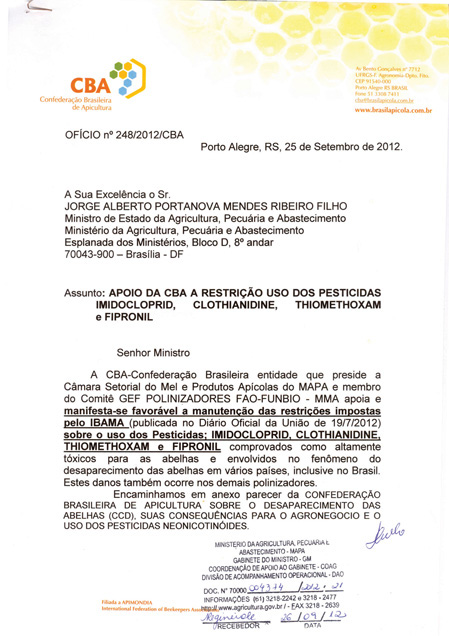
Opinion of the CBA about the disappearance of bees and their consequences for agribusiness and the use of neonicotinoid pesticides
Support the maintenance of restrictions imposed by IBAMA on the use of pesticides
On behalf of beekeepers and beekeepers in Brazil CBA filed in MMA, IBAMA, MAP, technical advice to support the maintenance of restrictions imposed by IBAMA (published in the Official Gazette of 19/07/2012) on the use of pesticides; Imidocloprid, CLOTHIANIDINE, THIOMETHOXAM And FIPRONIL proven to be highly toxic to bees and involved in the disappearance of bees phenomenon in many countries, including Brazil. This damage also occur in other pollinators. Thank you Dr.Lionel Segui Gonçalves – President of the Scientific Technical Commission in drawing up the document.
Jose Cunha – President
OPINION OF THE BEEKEEPING BRAZILIAN CONFEDERATION OF THE DISAPPEARANCE OF BEES (CCD), ITS CONSEQUENCES FOR AGRIBUSINESS AND USE OF PESTICIDES NEONICOTINOIDS
Currently the biggest problem of the world beekeeping lists- to the already known “Vanishing of the Bees” or “Collapse Disorder of Bees (Colony Collapse Disorder ou CCD). This issue has been of concern of the world's authorities and scientists, today being a theme much explored by the international media and the subject of many conferences. In September 2011 the International Federation of Beekeepers “APIMONDIA”, which brings together today 75 participating countries, held in Buenos Aires, Argentina another international conference where the theme disappearance of bees was again widely discussed. Since 2007 this topic has been debated in the international congress of Apimondia face the great damage that the disappearance of bees has caused to world agriculture. The age-old exploitation of beekeeping man is traditional for the benefits that it provides both to humans in food production and for nature, thanks mainly pollination capacity of bees that contribute to the reproduction of plants and, consequently, for increasing green areas on earth with plants guarantee our survival and animals in general. Unfortunately the phenomenon of the disappearance of bees has been growing on every continent and the whole world is on alert. We must remember that the then Nobel Prize in Physics, the scientist Albert Einstein predicted in his time, if the bees disappear from the earth, shortly after the men also succumb. Unfortunately, this prophecy runs a high risk of an actual face to the current phenomenon of the collapse of bees or disappearance of bees that is currently being observed in the United States, in Europe and in some countries of South America, including already several cases with significant losses in Brazil.
With this, the beekeeping agribusiness is in crisis in the world and the beekeeping sector in many countries has undergone a huge global impact, subject that has received special attention of the bee pathology experts and behavior of bees. This syndrome corresponds to the sudden disappearance of bees or reduction, in a few days, the size of the colony with queen, even in the presence of offspring, pollen and honey, however without a trace of death of bees. The CCD has caused serious casualties in the number of Apis mellifera colonies in the United States, Canada, Japan, India and some countries in Europe and South America (Oldroyd, 2007; Engelsdorp, van et al. 2008, Aizen & Harder, 2009, Potts et.al. 2010). European bee losses have been recorded in France, Spain, Italy, Switzerland, Sweden, France, Germany, Austria, Poland, England, Slovenia, Greece and Belgium (Gonçalves, 2012). Therefore, is perfectly predictable the damage that the lack of bees for pollination cause for agriculture. According to Brazilian researcher Dr. Dejair Message (personal info) in Brazil it has been detected several cases of disappearance of bees, both of Africanized bees and stingless bees. One of the first cases was detected in 2008 by The researcher. Malaspina (personal info) in Brotas, in the state of Sao Paulo, occasion when a beekeeper has lost more than 200 Africanized bee colonies after a light aircraft have sprayed with insecticide Thiomethoxam an orange culture. During a Symposium on Beekeeping Health held in April 2012 in Florianópolis-SC President of the Federation of Beekeepers of Santa Catarina reported losses 50 a 90% bee about to be transported to apple crops due to CCD. Beekeepers attending the symposium reported that a few months before taking their hives for apple pollination field, and in some cases a few days before, the colonies were well populated but at the time of transport detected high losses and often with empty hives, no appearance of looting or disease, characteristics that resemble the diagnosis of CCD. In the United States the value of the pollination service by bees in agriculture has been estimated as more than 20 million dollars, and more than three-quarters of known economic interest plants are pollinated by insects including the Apis mellifera and 1/3 the food we eat are from plants pollinated by bees, hence the importance of bees to agriculture and global concern for the disappearance of them, what is already happening in many countries. Segundo Engelsdorp et all (2008, 2010) in the United States was, between 2007 is 2008, a loss around 1 million colonies of Apis mellifera bees, wherein 21 states recorded losses ranging from 19% is 52%, with an average loss around 36%, what we consider as very worrying, since it does not yet have a forecast for its control. In 2010 is 1011 remained bee losses registered in the USA but also in Europe and South America (Carreck, N.L. 2011, Kristiansen, P. 2011, Potts et all. 2010). The causes of this disappearance are still reasons of discussion in congress, symposia and beekeeping seminars in several continents. Although there is a controversy on the subject of the main cause of the disappearance of bees, many factors have been identified as causing this phenomenon, but with a lot of attention lately been appearing pesticides indiscriminately pesticides used in agriculture, particularly those neonicotinoids such as Imidocloprid (gaucho or Confidor), the thiamethoxan (cruizer) and Clothianidine (poncho) etc. (Permanent Peoples’ Tribunal 2011).These insecticides have enzymatic activities that work on the physiology of bees such as the smell, in memory etc.. causing behavioral disorders. Regarding the memory bees start to have difficulties in orientation during the forage activities whose effects act on the central nervous system of bees, reaching its guidance and navigation system, determining thus a difficulty to return their home colonies, thus disappearing without a trace (Desneux, N. et all. 2007, Henry et all. 2012, Lu et all, 2012,). Bees usually have several types of diseases that attack young and adult, But the most cited causes so far for the loss of colonies or disappearance of bees or CCD has been: o Car Varroa destructor, microsporideo the Nosema ceranae, the stress caused by transport over long distances, absence of pollen, Virus wide ratio (APV-Acute Paralisis, IAPV-Israeli akute paralysis vírus, DWV-Deform Wing Virus, etc.) pesticides and (Ratia, G. 2008) etc. There is much controversy about the causes of CCD although recent published papers point pesticides such as CCD cause there is still much controversy over the main causative agent of CCD, there manifestations that there is a complex interaction between various factors and a synergistic effect between them that determines the collapse or disappearance of colonies (Pettis, J. 2011, Ritter, In. 2011). However, Recent studies published by Lu et al (2012), Henry et all (2012) by Whitehorn et all (2012) link the phenomenon of the disappearance of bees directly to the use of neonicotinoid pesticides and particularly imidacloprid to cause CCD, thus being shown that the main causes of the disappearance of the bees are not diseases or parasites, but the neonicotinoid pesticides which began to be used widely from the decade of 1990. In Brazil, research on the effect of pesticides made of honeybees proved that Fipronil causes serious problems in the development of bees, even using LD-50 at low concentrations (Silva et all. 2012). One of the facts that prove the great concern that had been occurring in Europe about the harmful effect of pesticides on bees was, according to Henrique Cortez (EcoDebate of Citizenship and Environment 30/8/2008) the prohibition of the German government on the use of eight neonicotinoid pesticides due to the mass death of bees in the state of Baden Wurttemberg. At the same time it was reported that both France and Italy and Slovenia have also banned entry into the country of some neonicotinoids. Although the phenomenon of the disappearance of bees come being researched by many researchers worldwide ,according to recent statements on the 6th National Symposium Beekeeping Chile, in 18/8/2012, do Sr. Gilles Ratia, President of Apimondia (personal info), CCD continues to be one of the biggest problems of the world beekeeping, occurring in many countries, reason still much controversy about its causes and still unsolved prospects. There is no doubt that pathogens, Mites, microsporide, Virus and other factors contribute to the health fragility of bees causing reduction of its disease resistance, It is partly responsible for CCD. However, It is evidenced clearly, in the work recently published by Lu et al (2012), Henry et all (2012) by Whitehorn et all. (2012), the last two in Science, the high toxicity and the serious damage caused by neonicotinoid pesticides for Apis mellifera bees and carpenter bees (Bumble bees), independente das doses, reinforcing the need to combat these pesticides. In this sense also recently Brazil launched its restrictions on the use of neonicotinoids in the country through an IBAMA Ordinance (published in the Official Gazette of 19/7/2012). Therefore, based on the information recorded here, there has become a major global concern about the use of pesticides in agriculture over the damage to bees. The phenomenon of the disappearance of bees poses a high risk to the world beekeeping and, consequently, for international agribusiness since all agricultural production worldwide related to grain and fruit dependent primarily by pollination bees. IT IS, therefore, fundamental combating neonicotinoid pesticides to Einstein's prophecy will not be reality. Given the above CBA – Brazilian Confederation of Beekeeping expects production of pesticides pesticides care more for the damage caused industries to bees and strive to produce more specific products against pests of agriculture but not toxic to abelhas.Concluindo, CBA expresses its support for maintaining the restrictions imposed by IBAMA on the use of pesticides IMIDOCLOPRID, CLOTHIANIDINE, THIOMETHOXAM and FIPRONIL proven to be highly toxic to bees and involved in the disappearance of bees phenomenon in many countries, including Brazil.
BIBLIOGRAPHIC REFERENCES:
AIZEN, M.A. & HARDER, L.D. 2009. The global stock of domesticated honey bees is growing slower than agricultural demand for pollination. Curr. Biol. 19:915-918.
CARRECK, N.L. 2011. Honey Bee losses in England, 2007-2010. Abstracts Book of the 42nd. International Apicultural Congress. Buenos Aires, Argentina, from 21st. To 25th. September. Pg. 161.
DESNEUX, N., DECOURTYE, A & DELPUECH, J.M. 2007. The Sublethal Effects of Pesticides on Beneficial Arthopods. Ann.Rew. of Entomology, 52: 81-106.’
Goncalves, L.S. 2012. Disappearance of the consequences (CCD) Bees of the International Bee Agribusiness and especially in Brazil. Proceedings of the X Meeting on Ribeirão bees Preto.Editores: FROM. L. P. Simões, M. M. G. Bitondi, A.D.Bontorim, F.S. Birth. FUNPEC Publisher. p:24-25.
HENRY,M., ROLLIN, O., APTEL,J.,TCHAMITCHIAN, S., Beguin,M., REQUIER, F., ROLLIN, O., DECOURTYE, A. 2012. A Common Pesticide Decreases Foraging Success and Survival in Honey Bees. Science, 2012.
KRISTIANSEN, P. 2011. Collony losses i Sweden. Abstracts Book of the 42nd. International Apicultural Congress. Buenos Aires, Argentina, from 21st. To 25th. September. Pg. 162.
LU, C., WARCHOL,K.M., CALLAHAN, R.A. 2012. In situ replication of honey bee colony collapse disorder. Bulletin of Insectology, 2012.
Oldroyd, B.P. 2007. What’s killing American Honey Bees ? PloS Bio.5(6) is 168.
PERMANENT PEOPLES’ TRIBUNAL 2011. Bayer’top-selling pesticides continues to cause bee deaths worldwide. www.cbgnetwork.org/4166.html.
PETTIS, J. 2011. A restrospective look at factors contributing to colony losses in the U.S. over the years. Abstracts Book of the 42nd. International Apicultural Congress. Buenos Aires, Argentina, from 21st. To 25th. September. Pg. 153-153..
POTTS, S.G., BIESMEYJER, J.C., Cream, C., NEUMANN, P. SCHWEIGER, O. & GET, W.E. 2010. Declines of managed honeybees and beekeepers in Europe. J.Apic.Res. 49,15-22.
RATIA, G. 2008. Bee losses, organic standard and importance of queen rearing. Apimondia Symposium-Puerto Vallarta, Mexico. Oc. 2008.
RITTER, In. 2011. Update on Bee Diseases. Abstracts Book of the 42nd. International Apicultural Congress. Buenos Aires, Argentina, from 21st. To 25th. September. Pg. 152.
SILVA, C.A.S., GUAPO, F., ABDALLA, F.C., MALASPINA, O., SILVA-ZACARIN, E.C.M. 2012. Fipronil causes serious disturbance in normal development of Africanized Apis mellifera. Proceedings of the X Meeting on Ribeirao bees Preto.Editores: Z.L.P.Simoes, M.M.G.Bitondi, A.D.Bontorim, F.S.Nascimento.Funpec Publisher. p: 470
From ENGLISH VILLAGE, D., HAYES, J.,UNDERWOOD, R.M., PETTIS, J.S. 2008. A survey of honey bee colony losses in the U.S. Fall 2007 to Spring 2008. PloS One, 3(12) is 4071.
From ENGLISH VILLAGE, D. & MEIXNER, M.D. 2010. A historical review of managed honey bee populations in Europe and the United States and the factors that may affect them. J. Invertebr. Pathol. 103, 80-95.
WHITEHORN, P.R., O’CONNOR, S., GOULSON,D., Wackers, F.L. 2012. Neonicotinoid Pesticide Reduces Bumble Bee Colony Growth and Queen Production.Science, 2012.

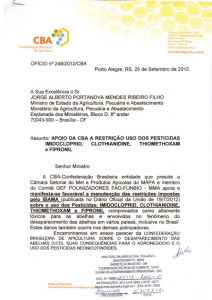
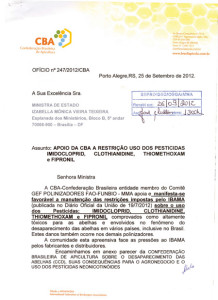
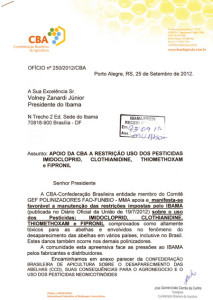
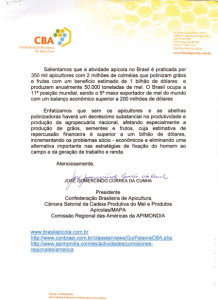
Sorry, the comment form is closed at this time.